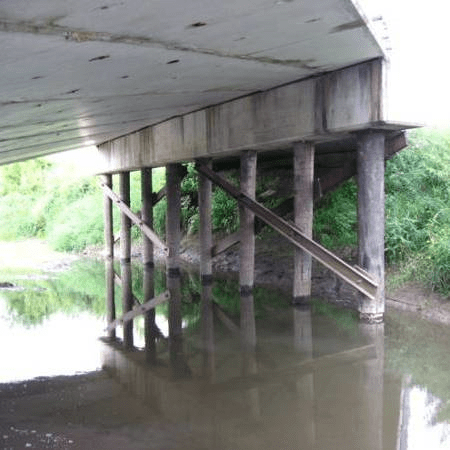Table of Contents
Timber piles generally refer to the type of pile foundation that comprises timber as the material of construction.
✔ Timber piles are mostly placed under the water level and can be rectangular or circular.
They have a long life span of approximately 30 years.
✔ During the design of timber piles, commonly the diameter is kept between 12 to 16 inches and the length is taken as 20 times the top diameter or less.
Such piles can withstand loads as high as 15 tons to 20 tons/pile.
✔ Usually, fish plates are attached or bolted on the side of the timber piles to gain additional strength.

Figure: Timber Piles
1. Advantages of Timber Piles
Some of the advantages of these piles can be listed as follows:
1. Timber piles are economical because of the easy availability of timber.
2. The installation process is relatively simple and easy.
3. The timber piles can be cut to the desired length even after installation and it has a lower possibility of damage.
4. In case, timber piles have to be removed, they can be easily pulled out.
2. Disadvantages of Timber Piles
Some of the disadvantages of these piles can be listed as follows:
1. Timber piles cannot be used as end-bearing piles.
2. The driving of timber piles is extremely difficult in the hard soil layer.
3. If proper care is not taken, defects may occur in timber.
4. Treatment of timber such as the application of preservatives must be carried out.
3. Quality of Timber Piles
Timber piles should have the following properties:
a. It should be free from defects and have sound quality.
b. It should be straight.
c. It should have a uniform taper.
d. It should be free from defects (decay, splits, the twist of wood grains, etc.), knots & holes, etc.
4. Classification of Timber Piles
Timber piles can be classified into the following types based on ASCE Manual no 17 in the section entitled “Timber piles and Construction Timber”:
| Class A pile | The minimum diameter for this class of piles is 14 inches.
Use: These piles are to be used for heavy loads or large unsupported lengths. |
| Class B pile | The minimum diameter for this class of pile ranges between 12 to 13 inches.
Use: These piles are used for medium loads. |
| Class C pile | The minimum diameter for this class of piles is 12 inches.
Use: These piles are used for a temporary structure. |
5. Preservative Treatment of Timber Piles
✔ As timber piles have to resist moisture, insects, fungi, termites, and different chemical and weathering effects.
So, timber piles should be well treated with preservatives to improve resistivity and durability.
✔ Commonly sufficient amount of creosote oil is impregnated properly in the timber piles for the preservation and to improve immunity against moisture, chemicals, insects, etc.
Cutting, drilling, and framing work should be done before the application of the creosote oil.
Abrasions and cuts should be covered with coats of creosote to prevent decay and biological as well as chemical attacks.
6. Over Driving of Timber Piles
Damage due to overdriving is one of the major drawbacks of the timber piles. Damage may occur at the tip or above. So, the design capacity of timber piles should be limited to 25 tons to prevent damages due to overdriving.
Blows per foot of penetration and behavior of pile upon load should be examined carefully. If there is any doubt of damage or possibility of damage; driving of piles should be stopped immediately and pulling out of two or more piles may be done to carry out the visual examination.
| Read Also: Types of Pile Foundation with Explanations |

